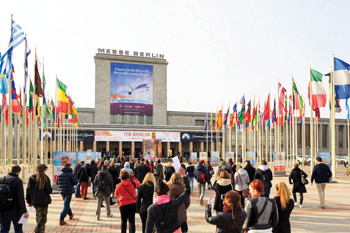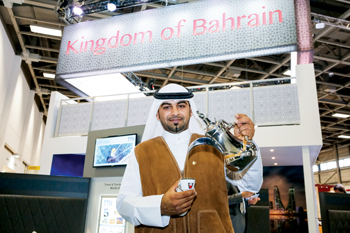ITB Preview
Watershed year for the biggest show
ITB Berlin 2016 will see quite a lot of new visitors, especially from the travel technology section. There is a high level of participation from the Middle East countries once again this year as the show celebrates its 50th anniversary

The world’s largest tourism trade fair, ITB Berlin, celebrating its 50th anniversary from March 9 to 13, is expected to generate billions of dollars in business, unite supply and demand from around the world again and send out an important message for the future, despite the difficult global economic situation, the refugee crisis and terror attacks, says David Ruetz, head of the show.
'According to our estimates the volume of sales at the world’s leading travel trade show was around €6.7 billion ($ 7.542 billion) in 2015. We expect at least the same number for 2016,' Ruetz tells TTN in an interview.'Many of the halls are already booked. We expect around 10,000 exhibitors and organisations from more than 180 countries to be in the 26 halls on the Berlin Exhibition Grounds,' he says. This year’s partner country is the Maldives, which offers one of the best examples of carefully controlled, ecological tourism development, which is a world apart from mass tourism. With its glistening white beaches, turquoise lagoons and unrivalled scuba diving, this island nation is a nature paradise that is one of the planet’s last, he says. Although the worldwide economic factors along with the refugee crisis in Europe are impacting very adversely on the global tourism industry, the overall trend remains satisfying. And 2015 has been another good year for world tourism. The Arabian outbound travel market is growing into a lucrative niche business as well-off travellers venture more beyond their home region and spend heavily on up-market accommodation, shopping and entertainment, he says. |
Ruetz ... show sends out important message |
What is the expected visitor count this year, as compared to last year?As visitor numbers are stable for many years, we expect the same number of visitors as in 2015: A total of about 170,000 visitors.
How many new exhibitors have signed on so far? How are bookings? Up or down from last year? Bookings are stable compared to 2015. We will see quite a lot of new visitors at ITB Berlin, especially from the travel technology section. Around 30 per cent of the exhibitors are newcomers to the show, including major international companies such as Tuniu (China), Bynder ’getbynder’ (Netherlands) and Clicktripz (US). Demand from Asia remains particularly high. In Hall 26 China Southern Airlines, as well as tour operators and destination management companies (DMCs), including Beijing Charmission Travel, Europe Champion Travel, Ideaindochina and HGH Travel and Trails of Indochina are represented for the first time. In the hall displaying India (5.2b) the state of Rajasthan is returning in 2016, having launched a new global marketing campaign. Following the disastrous earthquake in April 2015, Nepal is back with its campaign ’Nepal Now’, promoting the country as an attractive and safe tourism destination. There is also high growth in numbers from Canada, the US and Central Asia. In particular, there are many exhibitors from Russia. Numerous countries from Africa are back at the show following an absence. The arrival of several newcomers from Europe emphasises the increasing importance of ITB Berlin. Turkey, a popular holiday destination, is represented in its own hall (3.2) with 15 new exhibitors, a record figure.
 |
What kind of participation can we expect to see from the Middle East and Asia, and what market segments? There is a high level of demand from the Middle East once again this year. Occupying Hall 22 and 23, the Arab countries will be just as strongly represented as last year. Arab countries such as Egypt, Jordan, Morocco, Tunisia and the United Arab Emirates have already secured their places. The airline Emirates even expands its booth space this year and is certain to cause a stir with its new stand in Hall 22a.
Tell us more about this year’s line-up of conferences and event programmes. What are the highlights?The digital transition has taken giant strides forward in the travel industry. Nowadays, a robot welcoming guests to a hotel with glasses of champagne is no longer pure fantasy. Under the heading ‘Travel 4.0 – the digitalization of the travel industry’, the convention will examine a number of topics, including virtual reality, the digital transition and the use of humanoid robots in the tourism industry. On March 10, the ITB Hospitality Day will be welcoming ‘Mario’. He is the youngest employee at the Ghent Marriott Hotel in Belgium, speaks 19 languages and is the first humanoid robot to work in a hotel. His inventors and the hotel director will be explaining how he came into being, as well as his tasks at the hotel. On March 11 visitors to the ITB Marketing and Distribution Day will be able to witness a live demonstration of robots in action. AikoChihira, a humanoid robot, will be showing what tourism might look like in the future. In an interview later on, one of Toshiba’s experts managing the project will have more information about the technology giant’s future plans. A global, representative and exclusive survey carried out by Travelzoo will also establish whether there is a demand for robots among customers.
What inbound and outbound travel trends do you notice in Germany especially in relation to the Middle East and the GCC?The German National Tourist Board (GNTB) is able to look back at another record result for the German incoming tourism in 2015. In the summer months of June, July and August alone, German incoming numbers, at 35 million, were 6.7 per cent higher, compared with the 2014 high season. Germany ranks number one in European destinations of all trips abroad from the Arabian Gulf states. The volume of overnight stays from the Arabian Gulf states continues to increase at a double digit rate. From 2013 to 2014 Germany recorded a growth of more than 20 per cent. These are the latest available figures. Germany remained the ‘world travel champion’ as the worldwide number one outbound market for international tourism, followed by the US and the UK. Dubai is the most interesting destination for Germans in the UAE. Dubai Tourism reports 367,000 arrivals of Germans from January to October 2015 which is an increase of 11 per cent compared to 2014. In 2014, 135,000 Germans travelled to Abu Dhabi according to the figures of the Abu Dhabi Tourism & Culture Authority. Oman is a very interesting destination for Germans as well. In 2014, 59,400 guests came from Germany. One has to take into account the number of tourists on cruise trips which is not included in this figure. About 50,000 Germans took cruise trips arriving in the Oman in 2014.
Can you comment on the success of the free MOOC you promoted a few months ago?With its multi-session, free Massive Open Online Course (MOOC) on social media in tourism the ITB Academy provides tourism professionals with the latest information and updates their social media knowledge. The numbers of participants are rising each day. We received many enquiries of interested persons who wanted to take part and therefore have enlarged the offer by one month until April 1. We had several universities stating that they would love to offer this online course also to their students as a complementary content. We are definitively thinking about how to develop year-round content related products for the travel industry in future.
By Rashi Sen
